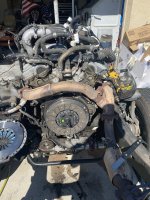The start

new frame work and welding up some stiffners...



coating it all



teardown







reassembly after new crutch install


dropping the engine pack back on tomorrow,, then the cab etc... probably a good 4 lazy days left but should be worth it. all because linex didn't coat the inside of the frame and it rusted out in a year... but that's another story. this frame shouldn't have that issue though, half a gallon of cavity wax and a about a gallon of undercoating so far...
new frame work and welding up some stiffners...
coating it all
teardown
reassembly after new crutch install
dropping the engine pack back on tomorrow,, then the cab etc... probably a good 4 lazy days left but should be worth it. all because linex didn't coat the inside of the frame and it rusted out in a year... but that's another story. this frame shouldn't have that issue though, half a gallon of cavity wax and a about a gallon of undercoating so far...


